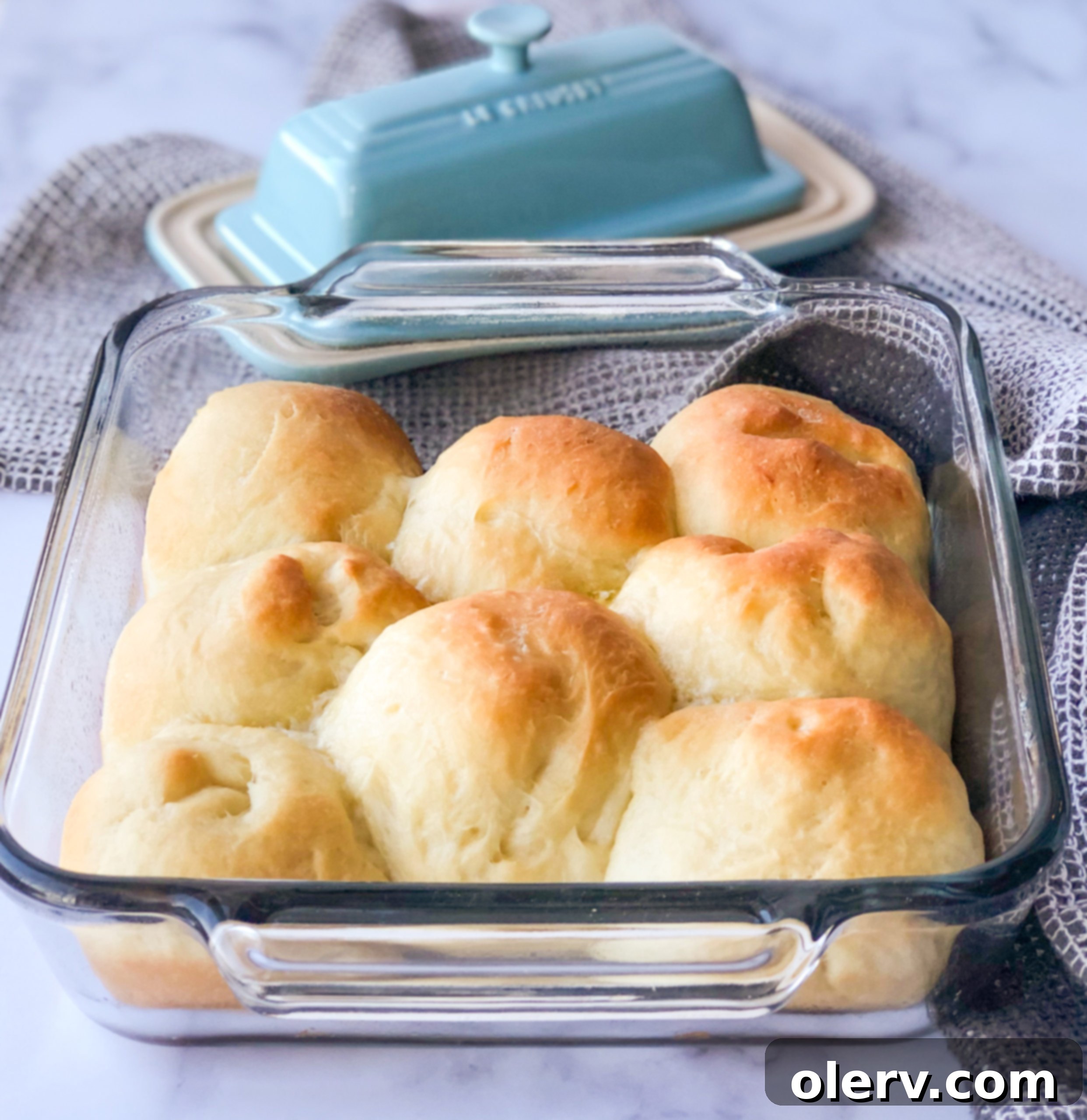Effortless Sourdough Dinner Rolls: Your Guide to Light, Fluffy, and Buttery Perfection
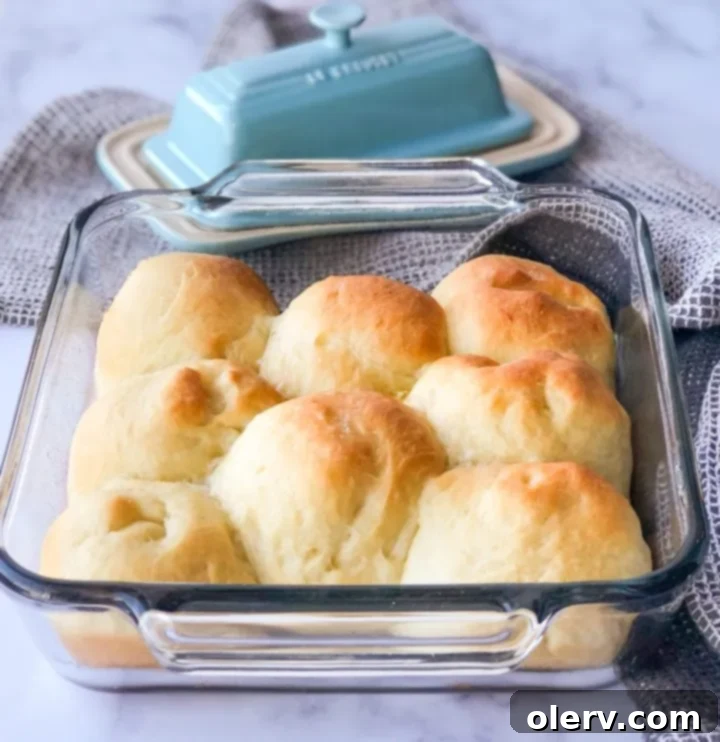
For years, I believed making homemade dinner rolls from scratch was an insurmountable culinary challenge. Visions of dense, dry, or deflated rolls often haunted my kitchen experiments. But I’m thrilled to tell you that those days are long gone! Today, I’m sharing a game-changing recipe for easy Sourdough Dinner Rolls that will transform your baking journey. These rolls are exceptionally light, incredibly fluffy, and infused with a rich, buttery flavor that’s simply irresistible. Forget spending an entire day chained to your kitchen; with just a few hours of hands-on and resting time, you can have a batch of warm, homemade sourdough rolls ready to grace your table. Let’s dive into the delicious details and get cooking!
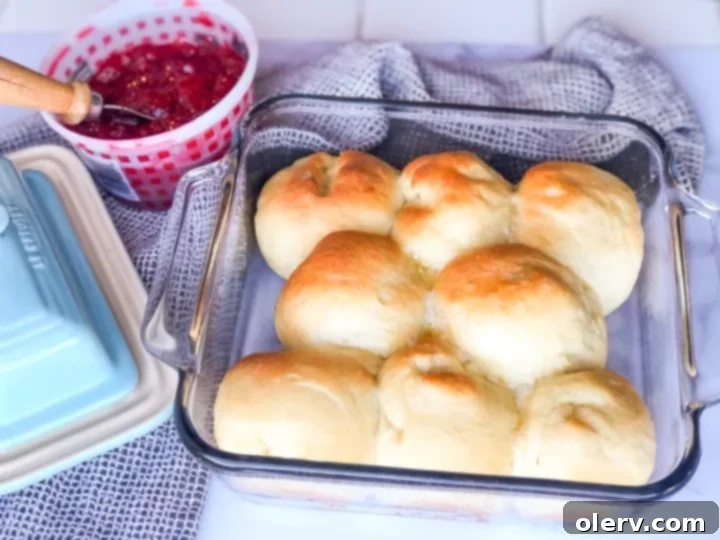
The Magic of Sourdough Starter in Your Dinner Rolls
The sourdough saga continues, and for good reason! Incorporating an active sourdough starter into your dinner rolls is the secret to achieving that distinct flavor profile and wonderfully chewy yet tender texture that sets these rolls apart. Sourdough doesn’t just add a touch of tang; it contributes to a depth of flavor that regular yeast rolls simply can’t match. For this particular recipe, I rely on my robust sourdough starter, a cherished gift that consistently delivers exceptional results. It’s crucial to have a fed and active sourdough starter ready to go for this Sourdough Dinner Rolls recipe.
If you’re new to the world of sourdough or looking to deepen your understanding, I highly recommend visiting my Instagram account. You’ll find a dedicated highlight bubble on my profile titled “Sourdough,” packed with invaluable tips. I’ve covered everything from how to create your very own starter from scratch, the best ways to share it with friends, essential feeding routines, and all the reasons why I’ve fallen in love with this traditional baking method. It’s a fantastic resource for any aspiring sourdough baker. Check it out here! www.instagram.com/thealexdaynes.
Beyond these delightful dinner rolls, the versatility of sourdough starter opens up a world of culinary possibilities. On my blog, you can explore other fantastic sourdough starter recipes, including my fluffy sourdough pancakes – perfect for a weekend brunch – and my incredibly simple easy sourdough pizza crust, which will elevate your homemade pizza nights. Each recipe showcases the unique benefits and incredible flavor that sourdough brings to everyday dishes.
Understanding Your Sourdough Starter: Fed and Ready to Bake
For this recipe, “fed sourdough starter” means your starter has been activated and is at its peak activity. This typically involves feeding it equal parts flour and water the night before, or 8-12 hours prior to baking, and leaving it on the counter at room temperature. A healthy, fed starter will be bubbly, active, and smell pleasantly yeasty with a hint of tang. It’s this active state that provides the leavening power and characteristic flavor for your rolls.
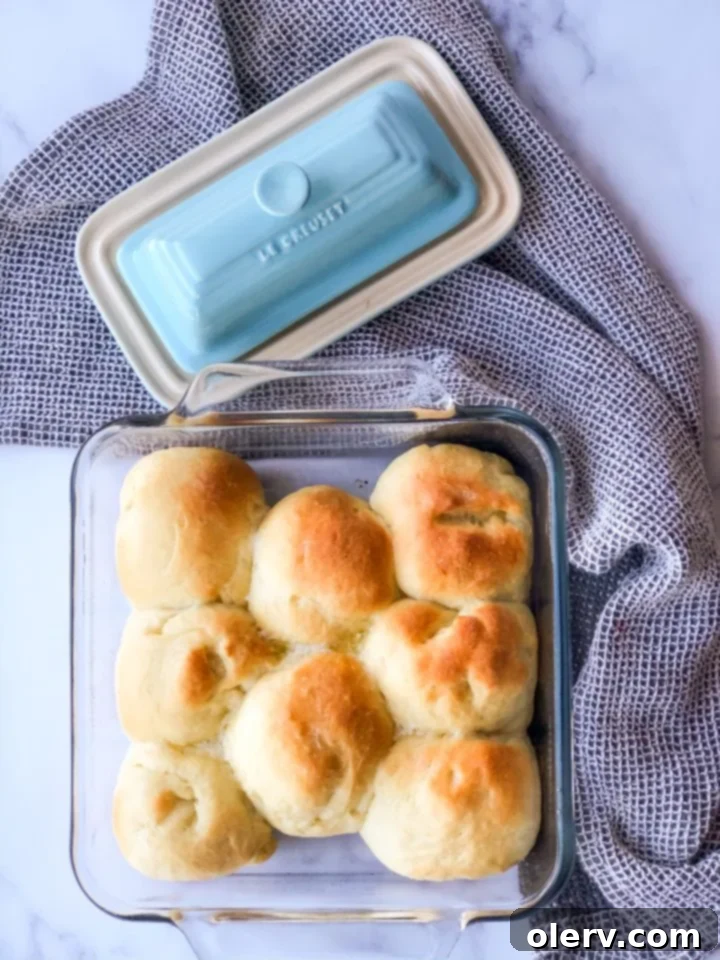
Why Do My Sourdough Dinner Rolls Touch in the Pan?
The practice of baking dinner rolls so they touch one another in the pan is a classic technique, and it’s key to achieving a specific and highly desirable texture. When these rolls are baked closely together in smaller baking dishes, they create a communal environment. This proximity ensures that each roll remains exceptionally soft and pillowy on all sides, as the internal steam and shared heat prevent crust formation where they meet. The result is those famously tender, “pull-apart” rolls that are incredibly satisfying to eat, while still allowing the bottom to achieve a beautiful golden-brown color and a slight crispness.
For optimal results, I recommend baking these rolls in round or square dishes that are approximately 8 or 9 inches in size. These dimensions provide the perfect snug fit for the rolls to rise and meld together without being overly crowded or spread too thin.
Of course, baking is all about personal preference! If you prefer your rolls to have a crustier exterior on all sides, you certainly don’t have to arrange them so they touch. You can simply spread them out on a larger cookie sheet, allowing more space between each dough ball. This method will still yield delicious rolls, just with a slightly different texture. However, we are big fans of the classic pull-apart style, which makes them perfect for sharing and adds to the rustic charm of homemade bread.
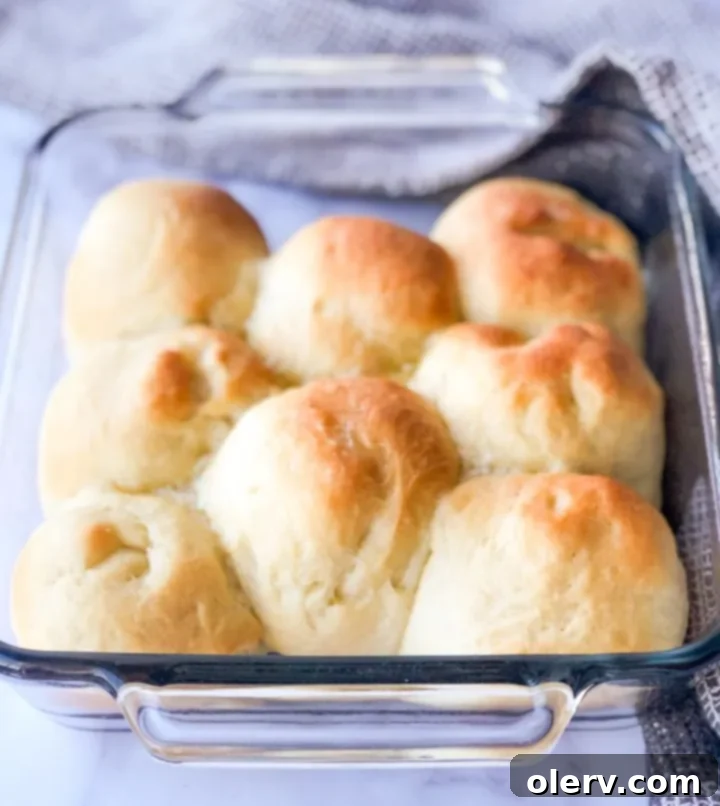
How Many Sourdough Dinner Rolls Will This Recipe Yield?
This versatile recipe is designed to produce a generous batch of delicious sourdough dinner rolls, typically yielding between 13 to 16 rolls. The exact number will largely depend on the size you decide to make each individual dough ball. If you’re aiming for more substantial, larger rolls – perfect for a hearty sandwich or alongside a robust stew – you’ll naturally make fewer rolls per batch. On the other hand, if you wish to stretch your dough further and get more “bang for your buck” (or simply prefer smaller, more delicate rolls), you can easily shape the dough into up to 16 beautifully crafted sourdough rolls.
This flexibility allows you to tailor your baking to the occasion. Planning a large family gathering? Make smaller rolls to ensure everyone gets one. Hosting a smaller, intimate dinner? Opt for larger rolls to make a statement. No matter the size, the quality of these light, fluffy, and buttery sourdough rolls remains consistently excellent.
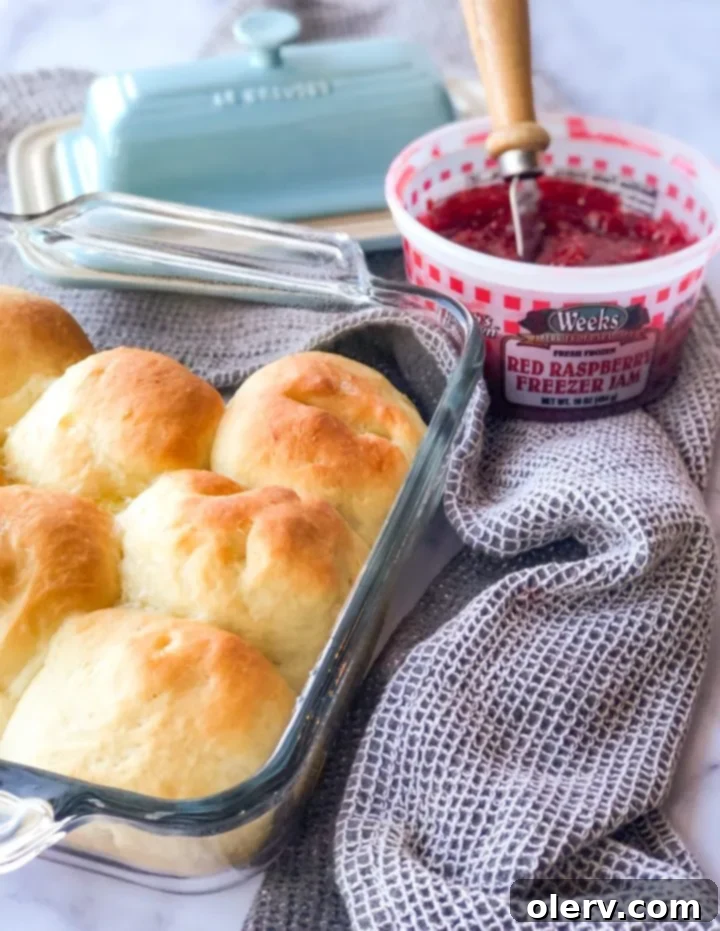
Tips for Sourdough Dinner Roll Success
Achieving bakery-quality sourdough dinner rolls at home is absolutely within reach with a few key considerations. Here are some essential tips to ensure your baking experience is smooth and your results are spectacular:
- Active Sourdough Starter is Key: As mentioned, your starter needs to be fed and active. This means it should be bubbly and have risen after its last feeding. A sluggish starter will lead to slow or no rise in your rolls.
- Room Temperature Ingredients: Ensure your butter is truly at room temperature (softened but not melted). This allows it to incorporate smoothly into the dough, leading to a more even and tender crumb. Lukewarm water is also crucial for activating the yeast and starter without shocking it.
- Don’t Rush the Kneading: Whether by stand mixer or hand, kneading develops the gluten, which is essential for the rolls’ soft, chewy texture. Knead until the dough is smooth, elastic, and passes the “windowpane test” (you can stretch a small piece of dough thin enough to see light through it without tearing).
- Warm Environment for Rising: Sourdough loves warmth. If your kitchen is cool, find a warm spot for your dough to rise – perhaps near a sunny window, in a slightly warm (but turned off) oven, or near a pilot light. Proper proofing is vital for light, airy rolls.
- Gentle Handling: Once the dough has risen, handle it gently when dividing and shaping the rolls. You want to preserve as much of the trapped air as possible.
- Don’t Overbake: Overbaking can lead to dry rolls. Keep an eye on them towards the end of the baking time. They should be a beautiful light golden brown on top. A quick brush with butter right out of the oven will add shine and extra flavor.
Serving and Storing Your Homemade Sourdough Rolls
These sourdough dinner rolls are incredibly versatile and make a fantastic addition to almost any meal. Serve them warm with a generous pat of butter, alongside a comforting bowl of soup or stew, or as a sophisticated accompaniment to your holiday roast. They’re also perfect for making mini-sandwiches or sliders with leftover meats.
To store your freshly baked rolls, once they’ve cooled completely, place them in an airtight container or a large zip-top bag at room temperature. They will stay fresh and soft for 2-3 days. For longer storage, these rolls freeze beautifully! Simply wrap them individually or in small batches in plastic wrap, then place them in a freezer-safe bag. They can be frozen for up to 3 months. To reheat from frozen, simply thaw at room temperature and then warm in a preheated oven (around 300°F/150°C) for 5-10 minutes, or until heated through.
Love this recipe and want to save it for later? Pin it to Pinterest here!
Sourdough Dinner Rolls
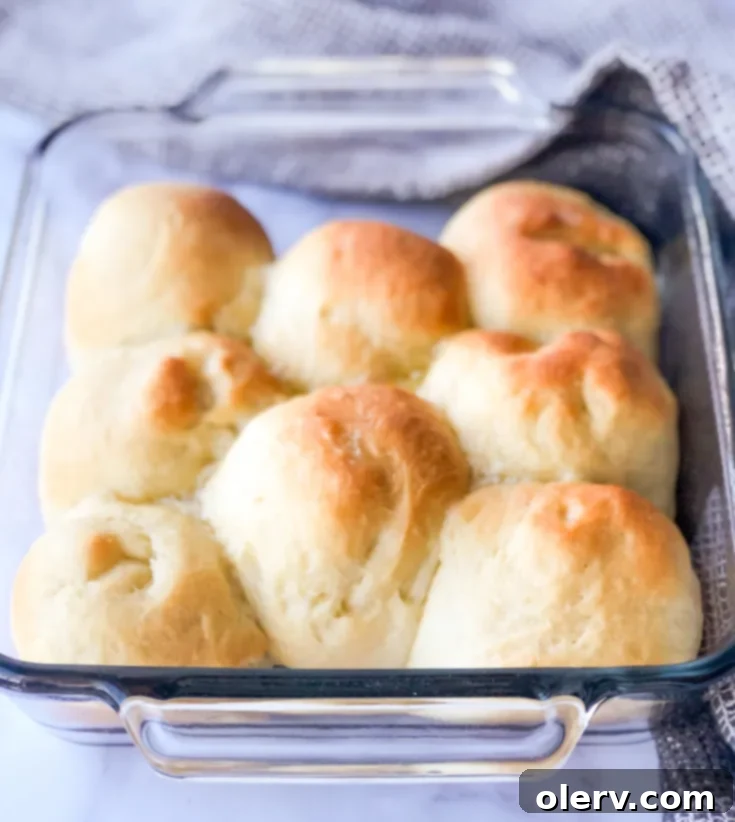
These easy Sourdough Dinner Rolls are light, fluffy, and buttery delicious! Seriously, so soft and flavorful! Plus, they won’t take you all day.
10 minutes
24 minutes
3 hours
3 hours 34 minutes
Ingredients
- 1/2 cup fed sourdough starter*
- 1 cup lukewarm water
- 2 3/4 cups all-purpose flour
- 1 1/2 teaspoons salt
- 2 tablespoons sugar
- 6 tablespoons unsalted butter, at room temperature
- 1/4 cup dry milk
- 1 1/2 teaspoons instant yeast
Instructions
- Add all of the ingredients to a stand mixer with the paddle attachment and beat until dough is formed. You may need to add additional flour or water, until you achieve a soft dough.
- Switch out your paddle attachment for your dough hook (or knead by hand on a floured surface) and knead for 3-5 minutes until the dough is soft and smooth.
- Place the dough into a lightly greased bowl, cover, and allow it to rise at warm room temperature until it’s nearly doubled in bulk, 60 to 90 minutes.
- While the dough is rising, lightly grease two 8 inch baking dishes.
- Next, divide it into 16 pieces. Shape each piece of dough into a ball. Place eight balls in each of the round pans. (balls shouldn’t touch one another at this point.)
- Cover the pans with a towel and allow the rolls to rise for one hour, or until they are puffy and double in size.
- While the rolls are rising, preheat the oven to 350°F.
- Bake the rolls for 24 to 26 minutes, until they’re a light golden brown on top.
- Remove the rolls from the oven and top with butter while hot.
- Enjoy!
Notes
*Fed sourdough starter means that your starter has been prepped the night before and left on the counter. Feeding the starter is simple: for this recipe, you would typically feed your starter with 1/2 cup flour and 1/2 cup of water. Cover it loosely and place it on the counter overnight. The next day, before measuring for the recipe, remember to reserve about 4 tablespoons of active starter to continue your culture for next time.
*Measure out the required 1/2 cup for this recipe from your fed starter, reserve the 4 tablespoons for your next baking session, and any remaining excess can be discarded or used in other discard recipes.
